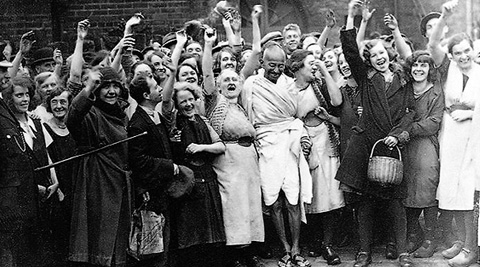THE HINDU JAN1,2018:Bapu in Africa
|
Bapu in Africa
|
|
|
Gandhi in Africa |
1- In 1893, he proceeded to Natal, South Africa in relation with a case involving his client, Dada Abdullah. 2- In South Africa, he witnessed apartheid (Racial discrimination against Blacks) to which Asians who had gone to South Africa as labourers were subjected. 3- He decided to stay in South Africa to organise the Indian workers to enable them to fight for their rights. 4- He stayed there till 1914 after which he returned to India in Jan 1915.
|
|
Moderate Phase of Struggle (1894-1906)
|
1- During this phase, Gandhi relied on sending petitions and memorials to the authorities in South Africa and in Britain 2- Hoping that once the authorities were informed of the plight of Indians, they would take sincere steps to redress their grievances as the Indians were, after all, British subjects. 3- To unite different sections of Indians, he set up Natal Indian Congress and started a paper ‘Indian opinion’.
|
|
Phase of Passive Resistance or Satyagraha (1906-1914)
|
1- The second phase, which began in 1906, was characterised by the use of the method of passive resistance or civil disobedience 2- Gandhi named it Satyagraha
|
|
Satyagraha against Registration Certificates (1906)
|
1- A new legislation in South Africa made it compulsory for Indians to carry at all times certificates of registration with their fingerprints. 2- The Indians under Gandhi’s leadership decided not to submit to this discriminatory measure. 3- Gandhi formed the Passive Resistance Association to conduct the campaign. 4- The Government jailed Gandhi and others who refused to register themselves. 5- The Indians under the leadership of Gandhi retaliated by publicly burning their registration certificates.
|
|
Campaign against Restrictions on Indian Migration
|
1- The earlier campaign was widened to include protest against a new legislation imposing restrictions on Indian migration. 2-The Indians defied this law by crossing over from one province to another and by refusing to produce licences |
|
Setting up of Tolstoy Farm
|
1- As it became rather difficult to sustain the high pitch of the struggle, Gandhi decided to devote all his attention to the struggle. 2- The Tolstoy Farm was meant to house the families of the Satyagrahis and to give them a way to sustain themselves.
|
|
Campaign against Poll Tax
|
1- A poll tax of three pounds was imposed on all ex-indentured Indians (Staying in South Africa after expiry of their contracts). 2- The inclusion of demands for the abolition of poll tax (which was too much for the poor ex-indentured Indians who earned less than ten shillings a month) in the ongoing struggle further widened the base of the campaign.
|
|
Invalidation of Indian Marriages
|
1- Fuel was added to the fire by a Supreme Court order which invalidated all marriages, not conducted according to Christian rites and by the registrar of marriages. 2- By implication, Hindu, Muslim and Parsi marriages were illegal and children born out of such marriages, illegitimate. 3- The Indians treated this judgement as an insult to the honour of their women and many women were drawn into the movement because of this indignity. 4- Even viceroy, Lord Hardinge, condemned the repression and called for an impartial enquiry. Eventually, through a series of negotiations involving Gandhi, Lord Hardinge, C.F. Andrews and General Smuts, an agreement was reached by which the Government of South Africa conceded the major Indian demands relating to the poll tax, the registration certificates and marriages solemnised according to Indian rites, and promised to treat the issue of Indian immigration in a sympathetic manner.
|
Working note:
In 1915, Lord Hardinge awarded Kesar-e-Hind medal for his services in Zulu and Boer wars but later he returned these medals for NCM in connection with Khilafat movement to Viceroy Chelmsford in 1920.
